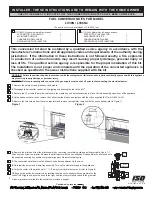
Transom Mount Intelliducer Installation Instructions
To mount the Intelliducer on a transom:
1. Position the Intelliducer mount at the selected transom location. Make sure the Intelliducer is
parallel with the water line. Mark the center locations of each hole on the Intelliducer mount.
Apply marine sealant to all screw
threads to prevent water from
seeping into the transom.
Mount the Intelliducer
cable cover far above
the waterline.
Intelliducer should extend
1
/
8
in. (. mm) below
a fiberglass hull or
3
/
8
in. (9.5 mm) below an
aluminum hull.
Ensure that the Intelliducer is
below water level when the boat
is on plane at high speed.
Do not mount the Intelliducer directly in the path of the
propeller. The Intelliducer can cause cavitation that may
degrade the boat performance and damage the propeller.
Mount the Intelliducer parallel
with the bottom.
2. Drill
5
/
32
in. (4 mm) pilot holes approximately 1 in. (25 mm) deep at the marked locations. To
avoid drilling the holes too deep, wrap a piece of tape around the bit at 1 in. (25 mm) from
the point of the bit.
3. Apply marine sealant to the 5 × 30 mm screws. Attach the Intelliducer assembly to the
transom using the 5 × 30 mm screws. Adjust the Intelliducer assembly to extend beyond the
bottom of the transom approximately
1
/
8
in. (3.2 mm) on fiberglass hulls or
3
/
8
in. (9.5 mm) on
aluminum hulls. Adjust the Intelliducer assembly to be aligned parallel with the water.
4. Tighten the 10-32 locking nut until it touches the mounting bracket, and then tighten
1
/
4
turn
more. (Do not overtighten.)
5. Place the first cable clamp on the Intelliducer cable, approximately one third of the distance
between the Intelliducer and the top of the transom.
6. Mark the location. Drill a
1
/
8
in. (3.2 mm) pilot hole approximately
3
/
8
in. (9.5 mm) deep.
7. Attach the cable clamp using one of the 4 × 12 mm screws. Coat the screw with marine
sealant before installation. Repeat steps 5 and 6 using the other cable clamp.
8. Route the NMEA 2000 cable to the backbone of your existing NMEA 2000 network.
OR
Route the power/data cable to power and a NMEA 0183-compliant device.
CAuTION:
Avoid routing the cable close to electrical wires or other sources of electrical
interference.


























